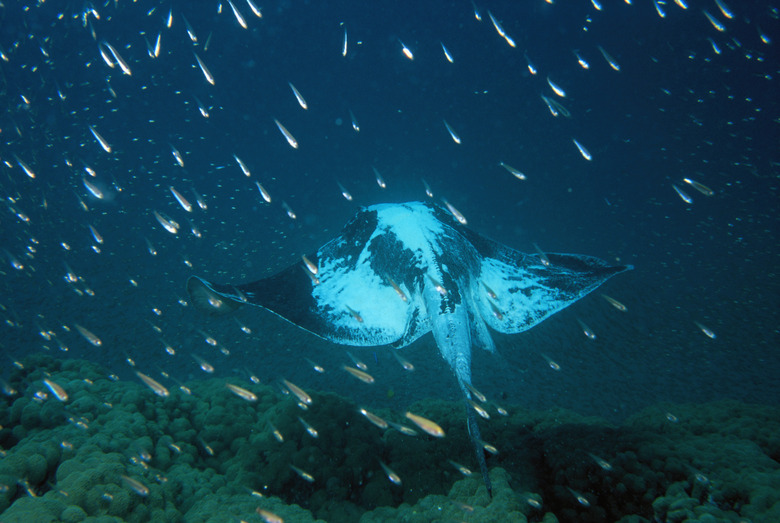The Ecosystem Of The Stingray
An ecosystem is where plants, animals and other living organisms interact with both each other and abiotic factors such as wind, water, sun and land in any given area. Ecosystems can be small, like an individual fallen tree stump, or vast like the ocean. Every living and nonliving component of an ecosystem plays a vital role in the system; stingrays are no exception. The genus Dasyatis contains at least 69 different species of stingrays. Size and weight vary depending on the species, but the largest can reach 6.5 feet and weigh 790 pounds.
Stingray Habitats
Stingray Habitats
Stingrays are mostly found in marine habitats around the world; however, there are a few freshwater species. The ideal stingray environments are benthic zones with sandy or muddy bottoms, seagrass beds and reefs. The benthic zone is the lowest section of water and includes the upper sediment layers of the ocean floor. Stingrays will often sit for long periods, partially buried in the top layers of sand or mud. Coastal species move in and out with the tides.
Stingray Breeding
Stingray Breeding
Baby stingrays are called pups. One cool thing about stingrays is that even though they are fish, they give birth to live young. The male stingray internally fertilizes the female's eggs; the female then carries the eggs in her uterus. Like any fish, the pups are nourished by the egg yolk until they are ready to hatch. The litter of pups hatches inside the mother before they are born. This type of reproduction is called ovoviviparity.
Stingray Feeding
Stingray Feeding
Stingrays feed primarily at night. They move along the muddy or sandy bottom, flopping their fins over the sand or shooting jets of water out of their mouths to disturb potential prey. With their eyes looking up and their prey beneath them, stingrays use electro-receptors, plus their senses of smell and touch, to find their food. They eat worms, crustaceans, mollusks, small fish and squid. Stingrays' strong jaws crush the shells and bones of their prey.
Predators of Stingrays
Predators of Stingrays
In every ecosystem food web, there are predators and prey. Sharks, elephant seals, orca whales and sometimes humans eat stingrays. Stingrays use the venomous spines and serrated barbs on the base of their tails as a defense mechanism when they feel threatened. Though they are not considered to be aggressive animals, their venom is toxic enough to kill a human.
Mutualistic and Parasitic Relationships
Mutualistic and Parasitic Relationships
A relationship is considered mutualistic when two organisms benefit from their interactions. A parasitic relationship is when one organism suffers and one benefits. Southern stingrays, Dasyatis americana, are prone to infestations of trematode ectoparasites, which live on the surface of their scales and feed on them. Southern stingrays have been seen to visit bluehead wrasse, Thalassoma bifasciatum, which act as cleaning stations where these ectoparasites, excess scales and mucus are removed. The stingrays benefit by having harmful parasites removed before the parasites cause severe damage, and the bluehead wrasse benefit by having a meal brought to them.
Commensal Relationships
Commensal Relationships
Commensal relationships are when one organism benefits while the other is neither harmed nor reaps any benefits from the interaction. Stingrays have commensal relationships with many fish and coastal birds such as cormorants. The stingrays' feeding behavior disturb small animals that live in the muddy or sandy bottom. Any small animals that the stingray doesn't eat then become prey for the other fish and birds following close behind. The fish and birds' presence doesn't affect the stingray, but the stingray helps them find their next meal.
Stingray Conservation
Stingray Conservation
Many species of stingrays are considered at risk or vulnerable. Stingrays are threatened by water pollution, habitat destruction and overexploitation. Marine-protected areas may help offset these problems and help build populations back to sustainable levels. A lot more research is needed to understand stingrays and their ecosystem interactions.
References
- Encyclopedia of Life: Whiptail Stingrays
- Monterey Bay Aquarium: Southern Stingray
- Zootaxa: A Revised Classification of the Family Dasyatidae (Chondrichthyes: Myliobatiformes) Based on New Morphological and Molecular Insights
- SeaWorld: Stingray Cuisine Facts
- Bioweb: Southern Stingray (Dasyatis Americana)
- ITIS Report: Dasyatis
- Wildlife Journal Junior: Dasyatidae, Whiptail Stingrays
- Florida Museum: Skate & Ray FAQ
- National Geographic: Stingrays
- Smithsonian's National Zoo and Conservation Biology Institute: Freshwater Stingray
- ICES Journal of Marine Science: Conservation of Coastal Stingrays: Seasonal Abundance and Population Structure of the Short-Tailed Stingray Dasyatis Brevicaudata at a Marine Protected Area
Cite This Article
MLA
Jerrett, Adrianne. "The Ecosystem Of The Stingray" sciencing.com, https://www.sciencing.com/ecosystem-stingray-17464/. 31 July 2019.
APA
Jerrett, Adrianne. (2019, July 31). The Ecosystem Of The Stingray. sciencing.com. Retrieved from https://www.sciencing.com/ecosystem-stingray-17464/
Chicago
Jerrett, Adrianne. The Ecosystem Of The Stingray last modified August 30, 2022. https://www.sciencing.com/ecosystem-stingray-17464/
